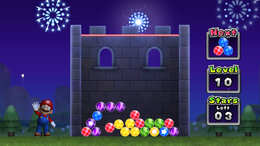Castle Clearout
| Castle Clearout | |||
|---|---|---|---|

| |||
| Appears in | Mario Party 9 | ||
| Type | Extra minigame | ||
| Music track | Super-Duper Mario Bros. | ||
| |||
Castle Clearout is an extra minigame featured in Mario Party 9. One to two players can play.
In single-player mode, players can earn two Party Points for each level that they clear; in two-player mode, players can earn five Party Points when the game is finished.
Gameplay[edit]
In single-player mode, the player can first select which level they may play (however, they must choose level one if it is their first time playing), and there are 50 levels total. The game is like Dr. Mario, in that the player must clear levels by placing a group of six marbles onto the ground to clear the marbles with a star pattern on them, as well as similarly colored marbles. The player can achieve this by rotating the marbles to match colors with them.
Clearing a group of marbles with similar colors in the shape of a line, pyramid, or hexagon also clears any other marbles of the same color. As the player passes through levels, more and more marble colors appear. Colors include red, blue, green, yellow, and purple, with the former three being the default colors.
Another similar element to Dr. Mario is that the player must avoid having the marbles touch the top of the area, or the player loses.
Lastly, as the player advances through each level, the marbles gradually fall at faster speeds, which can make it even harder to place them at the areas that the player wants. Additionally, the number of marbles to start out with gradually increases too.
In two-player mode, the players can select whether or not they want hints or handicaps. Both players start with an empty field, though gameplay is the same as in the single-player version. Additionally, clearing marbles in one of the formations causes marbles to fall onto the opponent's field. Players win when their opponent has stacked marbles above the red line, and the first player to win three out of five games wins the match.
In-game text[edit]
- Description from Extra Mode – "Connect six or more marbles of the same color to clear a group. Clear a group of marbles in certain patterns for special results."
- Rules 1 – "Connect six or more marbles of the same color to make them disappear. Clear all of the star marbles to move on to the next level. Clear marbles in certain formations for special results."
- Rules 2 – "These formations include Line, Pyramid, and Hexagon. Clearing marbles in a formation will cause all other marbles of the same color to disappear."
- Rules 1 (2 Players) – "Connect six or more marbles of the same color to make them disappear. Clear marbles in one of the three formations to send extra marbles raining down on your opponent!"
- Controls – "Hold the Wii Remote sideways. Press left or right on
 to move the marbles, and press down to make them drop. Press
to move the marbles, and press down to make them drop. Press  to rotate marbles left and
to rotate marbles left and  to rotate marbles right."
to rotate marbles right."
Names in other languages[edit]
| Language | Name | Meaning | Notes |
|---|---|---|---|
| Japanese | 6ボールパズル[?] Shikkusu Bōru Pazuru |
Six-Ball Puzzle | |
| Chinese | 堆疊6連珠[?] Duīdié liù liánzhū |
Stack-6 Renju | |
| French (Canada) | Château des billes[?] | Marble Castle | |
| French (Europe) | Donjon des gemmes[?] | Gem Keep | |
| German | Kugelpuzzle[?] | Ball Puzzle | |
| Italian | Di che colore 6?[?] | What color are you? | |
| Korean | 6볼퍼즐[?] Sikeuseu Bol Peojeul |
Six-Ball Puzzle | |
| Spanish (Latin America) | Castillo del seis[?] | Castle of Six | |
| Spanish (Europe) | Hexapuzle[?] | Hexapuzzle |
Notes[edit]
- If a player gets a Game Over in single-player mode in this minigame and does not break the current record, the player's character will do their fourth-place animation and say a quote that is not used elsewhere in the game (for example, Mario saying, "Mamma mia!" or Toad saying, "Oh, no!" from Mario Party 5).
- The "Too Bad!" message will also appear instead of the level number if the player fails the first level of their session (the "You Won!" music will play regardless, however).
- This is the only minigame where the "Too Bad!" message plays the "You Won!" music. Other minigames play the "Failed..." music.
- The "Too Bad!" message will also appear instead of the level number if the player fails the first level of their session (the "You Won!" music will play regardless, however).
- In Clubhouse Games: 51 Worldwide Classics for the Nintendo Switch, which was also developed by NDcube, this game reappears under its Japanese title, though it lacks any theming to the Super Mario franchise.